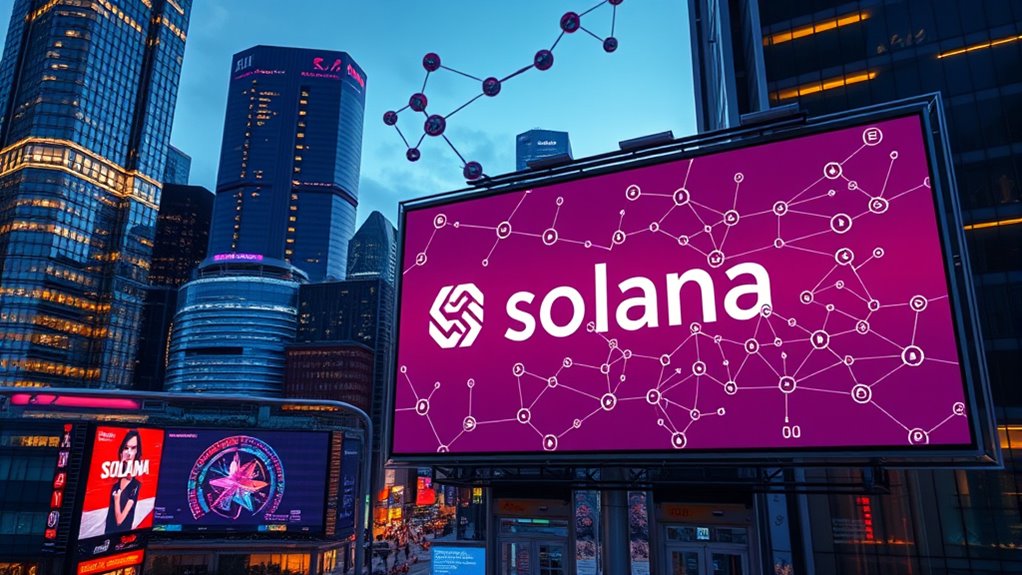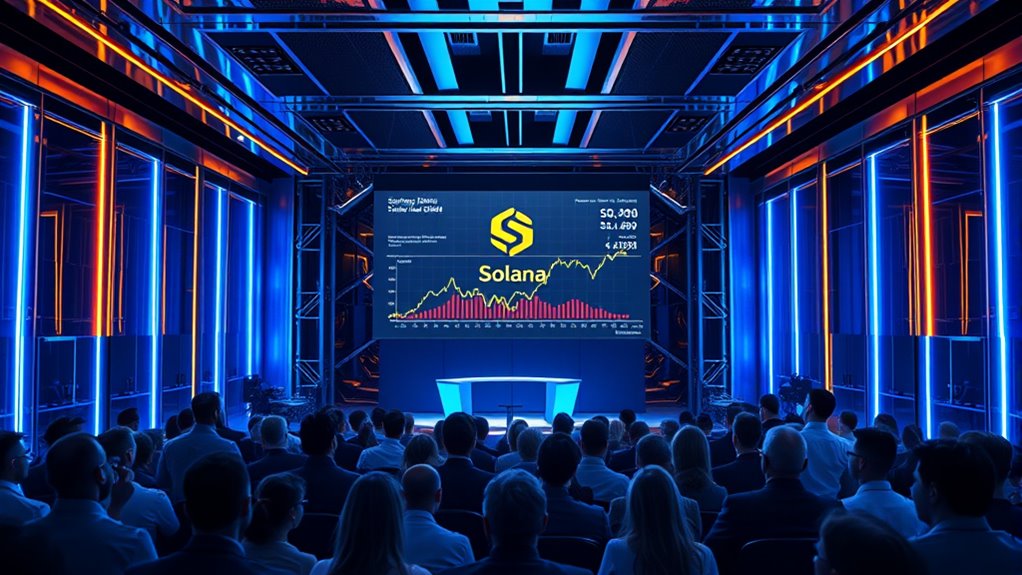Solana has become a Wall Street favorite because it offers lightning-fast transaction speeds, low fees, and a scalable architecture that supports large-scale decentralized applications and DeFi platforms. Its hybrid consensus mechanism guarantees high security and decentralization while processing over 65,000 transactions per second. This combination of speed, affordability, and reliability makes it attractive for institutional use. To understand the full picture behind Solana’s rise, there’s much more to explore.
Key Takeaways
- Solana offers high throughput (over 65,000 TPS) and low transaction costs, enabling efficient large-scale applications attractive to institutional investors.
- Its hybrid Proof of History and Proof of Stake consensus ensures fast, secure, and scalable transactions, supporting mainstream adoption.
- The network’s energy efficiency and low fees appeal to environmentally conscious and cost-sensitive investors.
- Solana’s growing ecosystem includes DeFi, NFTs, and gaming, fostering innovation and long-term growth potential.
- Strong technical architecture and ongoing upgrades position Solana as a reliable platform with a competitive edge in the blockchain space.
The Origins and Mission Behind Solana

Solana was founded in 2017 by Anatoly Yakovenko, a former Qualcomm engineer, with the goal of overcoming the limitations of earlier blockchains like Bitcoin and Ethereum, which struggled with slow transaction speeds and high fees. You’re likely aware that these early networks couldn’t scale efficiently for widespread use, limiting their potential for decentralized apps and finance. Yakovenko aimed to create a blockchain that could process thousands of transactions per second at minimal costs, making blockchain technology more accessible. Launched in March 2020 by Solana Labs, the platform was designed to deliver high speed, low fees, and scalability without sacrificing security or decentralization. Its mission is to build a fast, reliable network that can support mainstream adoption and a broad range of decentralized applications.
How Solana’s Hybrid Consensus Powers Its Speed

By combining Proof of History (PoH) with Proof of Stake (PoS), Solana creates a unique consensus mechanism that considerably enhances its transaction speed. PoH provides a cryptographic timestamp that orders events precisely, reducing communication overhead among validators. This means the network doesn’t need to wait for validators to confirm each step before proceeding, allowing for rapid processing. PoS selects validators based on the amount of SOL staked, incentivizing honest participation while keeping energy consumption low. AI security technologies play a role in safeguarding the network against cyber threats, ensuring the integrity of transactions. Together, these mechanisms streamline the validation process, enabling Solana to achieve high throughput with sub-second finality. This hybrid approach balances speed, security, and decentralization, making it possible for Solana to handle tens of thousands of transactions per second efficiently.
Key Components Driving Solana’s High Throughput

The impressive throughput of Solana relies on several innovative core components that work together to optimize network performance. These components streamline data flow and minimize latency, enabling thousands of transactions per second. Gulf Stream, for example, pushes transaction forwarding to the edge, reducing confirmation times. Sealevel allows parallel processing of smart contracts, increasing scalability. Turbine efficiently distributes data across validators, preventing bottlenecks. Additionally, the network’s electric bike infrastructure supports high-speed transactions and robust scalability. Together, these elements create a cohesive system capable of high throughput.
Performance Metrics and Cost Efficiency

You’ll notice that Solana’s speed and throughput set it apart, handling over 65,000 transactions per second with near-instant finality. Its transaction costs are impressively low, often under $0.01, making it cost-effective for users and developers alike. Plus, its energy-efficient Proof of Stake model helps maintain sustainability without sacrificing performance. Additionally, its high-performance architecture enables scalability and reliability essential for widespread adoption.
Speed and Throughput
How does Solana achieve such impressive speed and throughput? It combines innovative technology like Proof of History (PoH) with Proof of Stake (PoS) to streamline consensus. PoH creates a cryptographic timestamp, reducing communication between validators and enabling faster validation. Validators are selected based on staked SOL, which encourages honest participation and lowers energy consumption. Solana’s architecture includes components like Gulf Stream and Turbine, which optimize data propagation and processing. This setup allows the network to handle over 65,000 transactions per second, far surpassing Bitcoin and Ethereum. With such high throughput, transactions settle almost instantly, often within sub-second finality. The network’s scalability solutions are key to maintaining performance as demand grows. This combination of unique consensus, efficient architecture, and parallel processing makes Solana a leader in speed and scalability.
Transaction Costs and Fees
Solana stands out for its extremely low transaction costs, making it an attractive option for developers and users alike. You can send transactions for less than a penny, even during peak network activity. This affordability encourages high-volume applications and frequent interactions without breaking the bank. Unlike Ethereum, which often faces fee spikes during busy periods, Solana’s fee structure remains stable and predictable. This consistency helps developers plan costs and users avoid unexpected expenses. The network’s design, combining Proof of History and efficient architecture, ensures transactions are processed quickly and cheaply. As a result, Solana provides a cost-effective platform for decentralized finance, NFTs, and other dApps, supporting scalable growth without sacrificing transaction speed or affordability.
Energy Efficiency and Sustainability
Building on Solana’s low transaction costs, its energy efficiency further enhances its appeal by reducing environmental impact and operational expenses. Thanks to its Proof of Stake consensus, it consumes notably less energy than traditional Proof of Work systems. This approach not only lowers operational costs but also aligns with sustainability goals. You’ll find that Solana’s architecture ensures high throughput with minimal power use, making it scalable without sacrificing eco-friendliness. Additionally, the shelf life of digital assets can be extended through sustainable blockchain practices that prioritize energy efficiency.
Building a Vibrant Ecosystem of Dapps and NFTS

A vibrant ecosystem of dApps and NFTs is emerging on Solana, driven by its high throughput, low transaction fees, and developer-friendly environment. As a developer or user, you can build or access a wide variety of decentralized applications—from DeFi platforms to gaming and social media—without worrying about costly or slow transactions. Solana’s fast processing speeds and minimal fees make it ideal for creating and trading NFTs, attracting artists and collectors alike. The open-source nature encourages innovation and collaboration, fueling new projects and communities. Major projects like Serum, Raydium, and Solanart showcase the platform’s versatility. This thriving ecosystem not only attracts creators but also sustains user engagement, helping Solana establish itself as a leading hub for decentralized content and digital assets. Additionally, high throughput ensures that the network can handle a large volume of transactions efficiently, further supporting a dynamic and expanding ecosystem.
Challenges and Controversies That Test Solana’s Resilience

Despite its impressive technological design, Solana faces significant challenges that test its resilience. Network outages during high transaction volumes have raised concerns about stability. In August 2022, a major security breach compromised thousands of wallets, shaking confidence in its security measures. The platform also endures sharp price swings; after surging over 12,000% in 2021, SOL’s value plummeted amid market downturns and FTX’s collapse. Additionally, ongoing debates about decentralization persist due to validator concentration. The concerns about network stability and security risks continue to influence investor perceptions and community trust.
Regulatory Environment and Its Impact on Growth

Regulatory developments play a pivotal role in shaping Solana’s future growth. As regulators tighten their focus on cryptocurrencies, Solana faces increased scrutiny, especially around its token classification and security concerns. The 2023 SEC allegations that SOL may be an unregistered security create uncertainty, potentially limiting institutional adoption and access to traditional financial channels. Regulatory clarity could help legitimize Solana and encourage mainstream investment, but ongoing ambiguity may hinder growth and innovation. Additionally, compliance demands may increase costs for developers and exchanges operating on the network. You need to stay aware of evolving policies, as they could influence Solana’s scalability, user base, and partnerships. Ultimately, regulatory stability will be *essential* in determining whether Solana can sustain its competitive edge amid global financial oversight.
Solana’s Competitive Edge in the Blockchain Market

What sets Solana apart in the crowded blockchain landscape is its ability to deliver high speed and low transaction costs without sacrificing decentralization. This combination allows you to run complex dApps and DeFi projects efficiently while maintaining security. Its hybrid consensus model, combining Proof of History and Proof of Stake, enables lightning-fast processing—over 65,000 transactions per second—with minimal fees. You benefit from its scalable architecture, which avoids congestion and costly spikes common on other networks. Plus, Solana’s open-source ecosystem fosters innovation, attracting developers and entrepreneurs. Its focus on energy efficiency and low-cost transactions makes it appealing for mainstream adoption. Additionally, Solana’s Pimple Patch technology exemplifies its innovative approach by optimizing network performance and resilience. These factors give Solana a distinct competitive advantage, positioning it as a top-tier choice for blockchain applications demanding speed, scalability, and cost-effectiveness.
Future Outlook and Potential for Continued Adoption

The future of Solana looks promising as its strong technical foundation and expanding ecosystem attract ongoing interest from developers, investors, and mainstream institutions. You can expect continued innovation, especially as the network scales and new features emerge to address prior challenges. Its high throughput, low costs, and energy efficiency position Solana as a practical platform for decentralized applications, DeFi, and NFTs. Despite some setbacks, such as outages and regulatory concerns, the overall momentum remains positive. Institutional adoption is likely to grow as confidence stabilizes, especially with ongoing development and community engagement. As blockchain technology evolves, Solana’s emphasis on speed and scalability could help it maintain a competitive edge, making it a compelling choice for mainstream adoption and long-term growth. Additionally, its focus on scalability and innovative solutions may enable it to adapt more readily to future technological advancements and market demands.
Frequently Asked Questions
How Does Solana Maintain Decentralization With Its High Throughput?
You might wonder how Solana keeps decentralization despite its high throughput. It achieves this by using a hybrid consensus model combining Proof of History and Proof of Stake, allowing many validators to participate without sacrificing speed. Staking SOL encourages honest validation, while the network’s architecture distributes validation tasks efficiently. This setup enables numerous nodes to operate simultaneously, maintaining decentralization even as the network processes thousands of transactions per second.
What Security Measures Protect Solana From Network Attacks?
You’re protected by Solana’s hybrid consensus model, which combines Proof of History (PoH) and Proof of Stake (PoS). PoH provides a cryptographic timeline that makes it harder for attackers to manipulate the network, while PoS incentivizes honest participation through staking rewards. Additionally, validators are chosen based on their stake, and the network employs robust security protocols, making it resilient against attacks like double-spending or network congestion.
How Does Solana’s Tokenomics Influence Network Security and Stability?
Your understanding of Solana’s tokenomics shows that the SOL token plays a crucial role in network security and stability. When you stake SOL, you help validate transactions, which incentivizes honest participation. The more SOL you stake, the more secure the network becomes, as it reduces malicious attacks. Additionally, staking rewards encourage long-term holding, promoting stability and resilience, ensuring the network remains reliable and secure even during high traffic or potential threats.
What Are the Main Reasons Behind Solana’s Network Outages?
You should know Solana’s network outages happen mainly because of sudden traffic surges that overwhelm its validators, causing disruptions. Sometimes, bugs or software errors in network updates also trigger outages. When transaction volumes spike unexpectedly, validators struggle to keep up, leading to crashes or slowdowns. Despite these issues, Solana works to improve stability, but high demand and technical glitches remain key risks affecting network reliability.
How Is Solana Addressing Regulatory Challenges Globally?
You should know that Solana is actively engaging with regulators worldwide by improving its compliance measures and transparency. They’re seeking legal advice, updating their protocols, and collaborating with industry groups to adhere to evolving regulations. This proactive approach aims to reduce legal risks and foster trust among institutions. While challenges remain, Solana’s efforts to align with global standards show its commitment to steering through regulatory hurdles and expanding mainstream adoption.
Conclusion
In the fast-paced world of blockchain, Solana stands out like a shining star, blending innovation with speed. Its hybrid consensus keeps it ahead of the pack, even as challenges and controversies test its resilience. While the road ahead may not be a bed of roses, its vibrant ecosystem hints at a promising future. Keep an eye on Solana; it’s not just a fleeting trend but a force to reckon with in the digital age.









